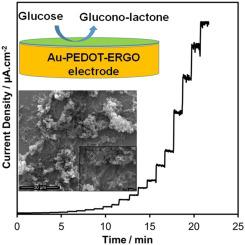当前位置:
X-MOL 学术
›
Synth. Met.
›
论文详情
Our official English website, www.x-mol.net, welcomes your
feedback! (Note: you will need to create a separate account there.)
Nonenzymatic glucose sensor based on poly(3,4-ethylene dioxythiophene)/electroreduced graphene oxide modified gold electrode
Synthetic Metals ( IF 4.0 ) Pub Date : 2020-10-01 , DOI: 10.1016/j.synthmet.2020.116488 Mesut Eryiğit , Emir Çepni , Bingül Kurt Urhan , Hülya Öztürk Doğan , Tuba Öznülüer Özer
Synthetic Metals ( IF 4.0 ) Pub Date : 2020-10-01 , DOI: 10.1016/j.synthmet.2020.116488 Mesut Eryiğit , Emir Çepni , Bingül Kurt Urhan , Hülya Öztürk Doğan , Tuba Öznülüer Özer

|
Abstract In this study, a nonenzymatic glucose sensor based on a Au electrode was modified using layered poly(3,4-ethylene dioxythiophene) (PEDOT) and electroreduced graphene oxide (ERGO). The modified electrode was characterized by X-ray photoelectron spectroscopy (XPS), scanning electron microscopy (SEM), and energy-dispersive X-ray spectroscopy (EDS). The electrochemical performance of the electrode material was evaluated to assess its use in glucose sensor applications. In addition, the effect of layer numbers of the layered composite on glucose activity was investigated. The monolayer PEDOT–ERGO nanocomposite exhibited high current density, high sensitivity, and low detection limit of approximately 5 mA cm−2, 696.9 μA mM−1 cm−2, and 0.12 μM, respectively. Moreover, an electrode interference test was conducted in the presence of various interfering species such as ascorbic acid, uric acid, dopamine, and H2O2, revealing excellent selectivity of the nonenzymatic glucose sensor. Thus, the PEDOT–ERGO modified Au electrode could be utilized as a promising nonenzymatic glucose biosensor.
中文翻译:

基于聚(3,4-乙烯二氧噻吩)/电还原氧化石墨烯修饰金电极的非酶葡萄糖传感器
摘要 在本研究中,使用层状聚(3,4-乙烯二氧噻吩)(PEDOT)和电还原氧化石墨烯(ERGO)对基于 Au 电极的非酶葡萄糖传感器进行了修饰。通过X射线光电子能谱(XPS)、扫描电子显微镜(SEM)和能量色散X射线能谱(EDS)对修饰电极进行表征。评估电极材料的电化学性能以评估其在葡萄糖传感器应用中的用途。此外,研究了层状复合材料的层数对葡萄糖活性的影响。单层 PEDOT-ERGO 纳米复合材料表现出高电流密度、高灵敏度和低检测限,分别约为 5 mA cm-2、696.9 μA mM-1 cm-2 和 0.12 μM。而且,在抗坏血酸、尿酸、多巴胺和 H2O2 等各种干扰物质存在下进行了电极干扰测试,揭示了非酶葡萄糖传感器的出色选择性。因此,PEDOT-ERGO 修饰的 Au 电极可用作有前途的非酶葡萄糖生物传感器。
更新日期:2020-10-01
中文翻译:

基于聚(3,4-乙烯二氧噻吩)/电还原氧化石墨烯修饰金电极的非酶葡萄糖传感器
摘要 在本研究中,使用层状聚(3,4-乙烯二氧噻吩)(PEDOT)和电还原氧化石墨烯(ERGO)对基于 Au 电极的非酶葡萄糖传感器进行了修饰。通过X射线光电子能谱(XPS)、扫描电子显微镜(SEM)和能量色散X射线能谱(EDS)对修饰电极进行表征。评估电极材料的电化学性能以评估其在葡萄糖传感器应用中的用途。此外,研究了层状复合材料的层数对葡萄糖活性的影响。单层 PEDOT-ERGO 纳米复合材料表现出高电流密度、高灵敏度和低检测限,分别约为 5 mA cm-2、696.9 μA mM-1 cm-2 和 0.12 μM。而且,在抗坏血酸、尿酸、多巴胺和 H2O2 等各种干扰物质存在下进行了电极干扰测试,揭示了非酶葡萄糖传感器的出色选择性。因此,PEDOT-ERGO 修饰的 Au 电极可用作有前途的非酶葡萄糖生物传感器。











































 京公网安备 11010802027423号
京公网安备 11010802027423号